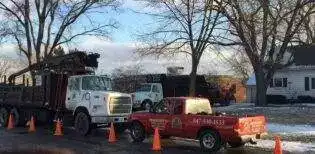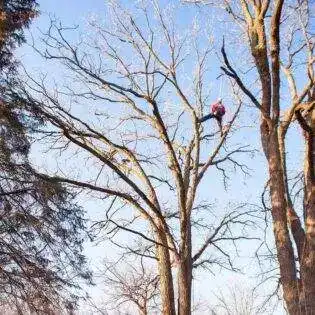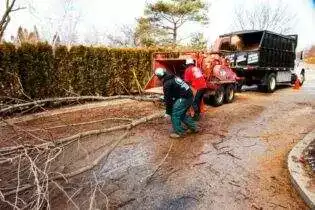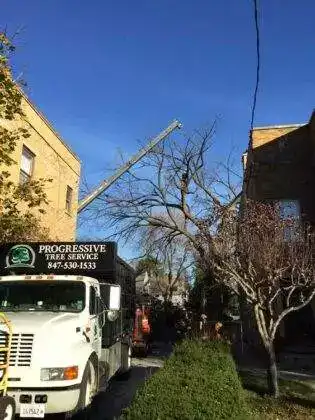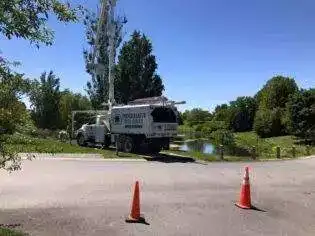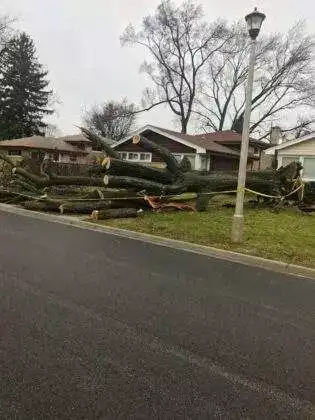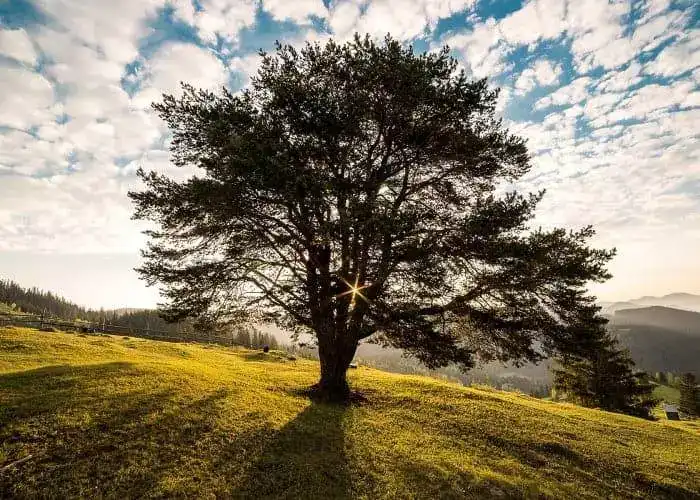What are bagworms?
The Bagworm, Thyridopteryx ephemeraeformis, is a common landscape pest native to the United States. The caterpillar is related to moths and survives by feeding on the foliage of affected trees. If their population is big enough, they can cause severe defoliation of the canopy.
For the longest time, the bagworm was most prevalent in the foliage of deciduous and coniferous trees east of the Rocky Mountains. However, recent years have seen the pest’s range extend further north, with bagworm outbreaks becoming more common in northern Ohio.
You’ll rarely see the bagworm itself but rather the quarter-inch to two-inch “bags” like upside-down ice cream cones that they make on affected trees. The worms construct them using the silk they produce and plant debris, making the bags perfectly camouflaged and harder to notice in some trees. This is especially the case in conifer trees, where the bags almost resemble cones.
Life cycle
Bagworms overwinter as eggs inside bags that hosted females in the previous year. When the eggs hatch in May to June, the larvae crawl out of the cocoons to feed on nearby foliage. They can move from one tree to another by releasing silken threads and letting the wind disperse them in a process called ballooning.
The larvae can also crawl from one branch to another.
Once the larvae find the perfect spot, they spin their tiny homes. These bags grow as the caterpillars continue to feed and grow and add more host plant material outside for camouflage.
Come August, the caterpillars molt into the pupal stage and form cocoons. In late August to early September, adult bagworms will emerge as moths from the cocoons. Female moths are flightless and thus, never leave their pupal case.
On the other hand, male moths have wings, and thus, the responsibility of looking for a suitable mate falls on them. Once they do, they mate through an opening at the bottom of the female’s bag. The females then lay their eggs inside their cocoons and die, marking the end of a cycle that will repeat come next year.
Tree species affected by Bagworms
Bagworms feed on the foliage of a whole variety of tree species, feeding on the canopy of more than 120 different species. In fact, they are one of the few species of insects that can eat the foliage of conifers and hardwood trees. Affected tree species include hemlock, spruce, bald cypress, sweetgum, linden, poplar, pine, fir, juniper, sycamore, elm, and buckeye, just to name a few.
How to Identify Bagworms
Bagworms are usually identified by the bags they make on twigs and branches. As the bags grow larger, they hang down like pine cones due to the weight. You may also notice defoliation of the canopy as a result of the caterpillar feeding on the foliage. On the rare occasion that you do see a bagworm caterpillar, here is a quick description of how they look;
- Depending on age, the caterpillars measure between ½ inches and two inches long.
- The head has a hardened capsule and is darker than the rest of the body, which is pale and soft.
- In the pupae stage, bagworms are dark brown. Males are more slender when compared to their female counterparts.
- Once they mature into moths, males are small and hairy with dark wings. The wings become more translucent as they age.
Consequences if left untreated
Bagworms start eating immediately after they land on a host to sustain their incredibly fast growth rate. On evergreen trees, they continuously feed on the buds and foliage, causing the tips of branches to turn brown and die. In serious cases, they can eat up to 80% of the evergreen and cause the entire tree to die.
On trees that lose their leaves in winter (deciduous), they chew small holes in the leaves. This can cause premature defoliation if left unchecked, but the tree will recover once you get rid of the bagworms.
The bags they construct are a pretty ugly sight that diminishes the aesthetic value of the affected tree. The twigs on which they rest are also more at risk of dying.
Treatment/prevention
Managing bagworms isn’t the prettiest of duties. You are advised to do it during fall, winter, or early spring before the eggs hatch, and this will involve handpicking and destroying bagworm bag clusters. If you have a particularly large infestation and thus, the job is too gross for your liking, you can always contact a professional arborist to do it for you.
Insecticides are most effective from early spring to midsummer, as newly hatched bagworm larvae are more sensitive to chemicals.
Final Take
Bagworms are destructive caterpillars that affect landscaping trees indiscriminately. They construct little bags where they live and continue to feed on the foliage of affected trees. Left unchecked, the caterpillars can defoliate and even kill entire trees while their bags make an unsightly mess.
Despite this, bagworms are pretty manageable and can be dealt with in a couple of ways. Make sure to consult a qualified arborist before you settle on a method of treatment.
